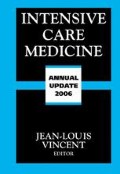Abstract
Traditionally, hyperlactatemia in critically ill patients and particularly those in shock was interpreted as a marker of secondary anaerobic metabolism due to inadequate oxygen supply inducing cellular distress [1]. Many arguments have since refuted this view [2]. With lactate metabolism being extensively described in classical biochemistry manuals, this chapter will focus only on those aspects as they relate to critically ill patients. Distinction between lactic acidosis, metabolic acidosis with hyperlactatemia, and isolated hyperlactatemia will also be addressed.
Access this chapter
Tax calculation will be finalised at checkout
Purchases are for personal use only
Preview
Unable to display preview. Download preview PDF.
References
Mizock BA, Falk JL (1992) Lactic acidosis in critical illness. Crit Care Med 20:80–93
Gladden LB (2004) Lactate metabolism-a new paradigm for the third millennium. J Physiol 558:5–30
Cohen RD, Simpson R (1975) Lactate metabolism. Anesthesiology 43:661–673
Alberti KG (1977) The biochemical consequences of hypoxia. J Clin Pathol Suppl (R Coll Pathol) 11:14–20
Leverve XM (1999) From tissue perfusion to metabolic marker: assessing organ competition and co-operation in critically ill patients? Intensive Care Med 25:890–892
Levy B, Sadoune LO, Gelot AM, Bollaert PE, Nabet P, Larcan A (2000) Evolution of lactate/pyruvate and arterial ketone body ratios in the early course of catecholamine-treated septic shock. Crit Care Med 28:114–119
Rivers E, Nguyen B, Havstad S, et al (2001) Early goal-directed therapy in the treatment of severe sepsis and septic shock. N Engl J Med 345:1368–1377
Gilbert EM, Haupt MT, Mandanas RY, Huaringa AJ, Carlson RW (1986) The effect of fluid loading, blood transfusion, and catecholamine infusion on oxygen delivery and consumption in patients with sepsis. Am Rev Respir Dis 134:873–878
Boekstegers P, Weidenhofer S, Kapsner T, Werdan K (1994) Skeletal muscle partial pressure of oxygen in patients with sepsis. Crit Care Med 22:640–650
Hotchkiss RS, Karl IE (1992) Reevaluation of the role of cellular hypoxia and bioenergetic failure in sepsis. JAMA 267:1503–1510
Stacpoole PW, Harman EM, Curry SH, Baumgartner TG, Misbin RI (1983) Treatment of lactic acidosis with dichloroacetate. N Engl J Med 309:390–396
De Backer D, Creteur J, Silva E, Vincent JL (2001) The hepatosplanchnic area is not a common source of lactate in patients with severe sepsis. Crit Care Med 29:256–261
Iscra F, Gullo A, Biolo G (2002) Bench-to-bedside review: lactate and the lung. Crit Care 6:327–329
Zeller WP, The SM, Sweet M, et al (1991) Altered glucose transporter mRNA abundance in a rat model of endotoxic shock. Biochem Biophys Res Commun 176:535–540
Gore DC, Jahoor F, Hibbert JM, DeMaria EJ (1996) Lactic acidosis during sepsis is related to increased pyruvate production, not deficits in tissue oxygen availability. Ann Surg 224:97–102
Vary TC (1996) Sepsis-induced alterations in pyruvate dehydrogenase complex activity in rat skeletal muscle: effects on plasma lactate. Shock 6:89–94
Lynch RM, Paul RJ (1987) Compartmentation of carbohydrate metabolism in vascular smooth muscle. Am J Physiol 252:C328–334
Barron JT, Gu L, Parrillo JE (2000) NADH/NAD redox state of cytoplasmic glycolytic compartments in vascular smooth muscle. Am J Physiol Heart Circ Physiol 279:H2872–2878
James JH, Wagner KR, King JK, et al (1999) Stimulation of both aerobic glycolysis and Na (+)-K (+)-ATPase activity in skeletal muscle by epinephrine or amylin. Am J Physiol 277:E176–186
James JH, Fang CH, Schrantz SJ, Hasselgren PO, Paul RJ, Fischer JE (1996) Linkage of aerobic glycolysis to sodium-potassium transport in rat skeletal muscle. Implications for increased muscle lactate production in sepsis. J Clin Invest 98:2388–2397
Clausen T, Flatman JA (1980) Beta 2-adrenoceptors mediate the stimulating effect of adrenaline on active electrogenic Na-K-transport in rat soleus muscle. Br J Pharmacol 68:749–755
Levy B, Gibot S, Franck P, Cravoisy A, Bollaert PE (2005) Relation between muscle Na+K+ ATPase activity and raised lactate concentrations in septic shock: a prospective study. Lancet 365:871–875
Leverve XM, Mustafa I (2002) Lactate: A key metabolite in the intercellular metabolic interplay. Crit Care 6:284–285
Schurr A, Payne RS, Miller JJ, Rigor BM (1997) Brain lactate is an obligatory aerobic energy substrate for functional recovery after hypoxia: further in vitro validation. J Neurochem 69:423–426
Kline JA, Thornton LR, Lopaschuk GD, Barbee RW, Watts JA (2000) Lactate improves cardiac efficiency after hemorrhagic shock. Shock 14:215–221
Levraut J, Ciebiera JP, Chave S, et al (1998) Mild hyperlactatemia in stable septic patients is due to impaired lactate clearance rather than overproduction. Am J Respir Crit Care Med 157:1021–1026
Stacpoole PW, Nagaraja NV, Hutson AD (2003) Efficacy of dichloroacetate as a lactate-lowering drug. J Clin Pharmacol 43:683–691
McCarter FD, James JH, Luchette FA, et al (2001) Adrenergic blockade reduces skeletal muscle glycolysis and Na(+), K(+)-ATPase activity during hemorrhage. J Surg Res 99:235–244
Stewart PA (1983) Modern quantitative acid-base chemistry. Can J Physiol Pharmacol 61:1444–1461
Bakker J, Gris P, Coffernils M, Kahn RJ, Vincent JL (1996) Serial blood lactate levels can predict the development of multiple organ failure following septic shock. Am J Surg 171:221–226
Manikis P, Jankowski S, Zhang H, Kahn RJ, Vincent JL (1995) Correlation of serial blood lactate levels to organ failure and mortality after trauma. Am J Emerg Med 13:619–622
Bellomo R, Ronco C (1999) The pathogenesis of lactic acidosis in sepsis. Curr Opin Crit Care 5:452–457
Author information
Authors and Affiliations
Editor information
Editors and Affiliations
Rights and permissions
Copyright information
© 2006 Springer Science + Business Media Inc.
About this paper
Cite this paper
Levy, B. (2006). Lactic Acidosis and Hyperlactatemia. In: Vincent, JL. (eds) Intensive Care Medicine. Springer, New York, NY. https://doi.org/10.1007/0-387-35096-9_9
Download citation
DOI: https://doi.org/10.1007/0-387-35096-9_9
Publisher Name: Springer, New York, NY
Print ISBN: 978-0-387-30156-3
Online ISBN: 978-0-387-35096-7
eBook Packages: MedicineMedicine (R0)

